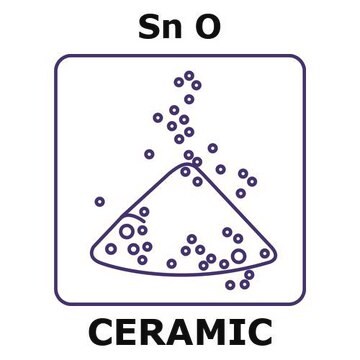549657
Tin(IV) oxide
nanopowder, ≤100 nm avg. part. size
Synonyme(s) :
Tin oxide, Stannic oxide
About This Item
Produits recommandés
Forme
nanopowder
Niveau de qualité
Caractéristiques du produit alternatif plus écologique
Design for Energy Efficiency
Learn more about the Principles of Green Chemistry.
sustainability
Greener Alternative Product
Taille moy. des particules
≤100 nm
Densité
6.95 g/mL at 25 °C (lit.)
Application(s)
battery manufacturing
Autre catégorie plus écologique
Chaîne SMILES
O=[Sn]=O
InChI
1S/2O.Sn
Clé InChI
XOLBLPGZBRYERU-UHFFFAOYSA-N
Vous recherchez des produits similaires ? Visite Guide de comparaison des produits
Description générale
Application
Code de la classe de stockage
11 - Combustible Solids
Classe de danger pour l'eau (WGK)
nwg
Point d'éclair (°F)
Not applicable
Point d'éclair (°C)
Not applicable
Équipement de protection individuelle
Eyeshields, Gloves, type N95 (US)
Faites votre choix parmi les versions les plus récentes :
Déjà en possession de ce produit ?
Retrouvez la documentation relative aux produits que vous avez récemment achetés dans la Bibliothèque de documents.
Les clients ont également consulté
Articles
Synthesis, Properties, and Applications of Perovskite-Phase Metal Oxide Nanostructures
Increasing fuel costs and concerns about greenhouse gas emissions have spurred the growth in sales of hybrid electric vehicles (HEVs) that carry a battery pack to supplement the performance of the internal combustion engine (ICE).
Nanomaterials for Energy Storage in Lithium-ion Battery Applications
Recent demand for electric and hybrid vehicles, coupled with a reduction in prices, has caused lithium-ion batteries (LIBs) to become an increasingly popular form of rechargeable battery technology.
Global Trade Item Number
| Référence | GTIN |
|---|---|
| 549657-25G | 4061832575384 |
| 549657-5G | 4061832575391 |
Notre équipe de scientifiques dispose d'une expérience dans tous les secteurs de la recherche, notamment en sciences de la vie, science des matériaux, synthèse chimique, chromatographie, analyse et dans de nombreux autres domaines..
Contacter notre Service technique









